Dell Latitude 5289 125 Fhd/touchscreen Business Convertible Review
Dell Latitude 5289 (i5, 256GB, 8GB) Convertible Review
Flexibility and stamina. Convertible notebooks with 360° hinges take become more than and more than popular in the past years and even businesses have started using them. Naturally, Dell would like a slice of the pie and has consequently launched the Breadth 5289. Read our detailed review to notice out why information technology will have a hard time asserting itself despite its disarming performance.

For the original High german review, see hither.
PC convertibles have quite a long history. This sector used to be dominated by convertibles with swivel hinges, including Dell's Latitude convertibles. The last device of this series that nosotros tested was the Breadth XT3, which was based on a 2011 Sandy Bridge processor.
A lot has changed since then, and convertibles with hinge hinges have all but disappeared from the marketplace. Instead, convertibles with 360° hinges have established themselves, with the pioneer in the business sector being Lenovo with its ThinkPad Yoga. Dell has now defenseless upwards and can offer its own equivalent for the business concern sector - today'due south test unit, the Latitude 5289. This device is in direct competition with Lenovo'southward ThinkPad Yoga 370 and HP'southward EliteBook x360.
The entry-level US version is available for $1284 in the Dell online shop. Our mid-range test unit with Cadre i5, 256 GB SSD and 8 GB of RAM can currently be purchased for about $1328 on the Dell online shop.
Display
12.50 inch 16:9, 1920 x 1080 pixel 176 PPI, 10-point, native pen support, BOE NV12N51, IPS LED, Gorilla Glass 4, glossy: yep
Mainboard
Intel Kaby Lake-U Premium PCH
Storage
SanDisk X400 256GB, SATA (SD8SB8U-256G), 256 GB
Weight
1.34 kg ( = 47.27 oz / two.95 pounds), Power Supply: 250 g ( = 8.82 oz / 0.55 pounds)
Note: The manufacturer may apply components from unlike suppliers including display panels, drives or memory sticks with similar specifications.
One of the nigh important steps in developing a business notebook is creating a instance that is stable, durable and applied. Information technology seems that Dell wanted to add an boosted element to the mix: inconspicuousness. This is not necessarily bad - unproblematic design can be very beautiful. On the exterior, the Latitude 5289 looks similar the other models of the Latitude 5000 series. The case is angular with slightly rounded edges and the case becomes minimally slimmer towards the forepart. It has a deep blackness color, and merely the shiny silverish Dell logo in the middle of the display comprehend stands out. The exterior of the Latitude radiates professionalism - after all a desirable quality in the business organization sector.
Except for the Gorilla glass 4 protected brandish and metallic hinges, the entire case has a safety coating. This also fits well with its businesslike character; the rubber surface has more grip, so the device is less probable to sideslip out of your hand. It also feels pleasant to the touch on and of high quality. Fingerprints and grease marks do not show up quickly, but when they do, they are not so easy to remove.
Supporting the rubber surface is magnesium, which makes the Breadth 5289 very robust and stable. Fifty-fifty under force, the display cover warps just minimally, the wrist rest does not give way at all. The base of operations can be dented minimally in the heart of the keyboard, but only at unrealistically high pressure. Force per unit area on the display has no outcome on the image. The same goes for workmanship every bit there are no noticeable burrs or gaps. Unfortunately, Dell did accept ane mishap: the device came with a stripped screw at the bottom of the case. Nosotros are assuming that this was a one-off assembly fault, but it is however rather unpleasant.
Hinges play an important role in convertibles and and then deserve to be examined separately. The design with two hinges is a standard for 360° convertibles; Dell has additionally designed them in a way that the display does not prevarication apartment on the table when the device is open at 180° - unlike Lenovo and HP'southward competitors. Which of these two designs you prefer is a thing of gustatory modality. In any case, the hinges do a good task and hold the display securely in position without any wobbles. Unfortunately, this also ways that you lot cannot open the brandish with 1 mitt, just at to the lowest degree Dell added a small indentation at the front end of the base of operations. Small details like this are often not appreciated enough; the indentation makes opening the display easier.
Out examination unit has a 12.5-inch display. This makes it the smallest of all the comparison devices, which all have thirteen.3-inch displays (except for the Yoga 910, which has a 13.9-inch brandish). Withal, it is non the smallest convertible - the XPS 13 two-in-ane is even more than meaty due to its thin bezels. The Latitude 5289 is the thickest device, simply this too affords it more stability. But the ThinkPad Yoga 370 is similarly thick. The XPS 13 ii-in-1 is not just the smallest, but also the lightest comparison device. Our test unit is a niggling heavier at 1.3 kg (~two.9 pounds); the 2 Lenovos counterbalance the near at ane.4 kg (~3.3 lb).
❌
Dell has given the Latitude two USB Blazon-C ports on its left side. However, they are both "normal" USB three.0 ports that additionally role equally DisplayPort and power supply. The Latitude 5289 does not have Thunderbolt, which puts it at a disadvantage compared to its straight competitors Lenovo and HP. Apart from that, it has a good (only non fantabulous) port option for a pocket-size concern notebook with 2 USB 3.0 Type-A ports and an HDMI port. Unfortunately, Dell has followed the trend of using MicroSD slots; the aforementioned is the instance for the EliteBook x360 and ThinkPad Yoga 370.
The positions of the ports are fine, although information technology would have been squeamish to accept one of the USB Type-C ports on the right, to be able to charge it from either side. Only this is no real disadvantage, rather a missed chance.
The Intel Wireless 8265 is a normally used 2x2 AC WLAN carte, especially with concern notebooks. This is not surprising, since it offers a stable and fast connection even at a greater altitude to the router. The Latitude 5289 is no exception. In our criterion, the Lenovo ThinkPad Yoga 370 did slightly better with the same WLAN card, but the divergence is non very big.
Unlike its direct competitors, our test unit of measurement is not equipped with a fingerprint reader, but apparently this is available optionally. It is equipped with a smart menu reader, a Kensington lock slot and TPM.
The U.s.a. version of the Latitude comes with an Active Pen. For docking, you lot volition accept to resort to the USB Type-C, as more powerful Thunderbolt iii docks cannot be used every bit the device has no suitable port. For this device, you would therefore need the Dell WD15 dock, which charges the notebook via USB Type-C.
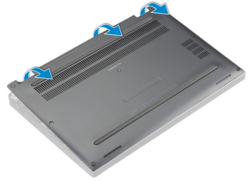
Because of the same stripped screw, we decided not to open the test unit. In theory, the bottom encompass should be easy to remove, but there are some plastic clips at the back that need to exist opened. Once the bottom cover is removed, all components including the cooling fan can exist accessed. The keyboard is not then easy to remove, but that has become normal for Ultrabooks.
The User's Manual, which is available on Dell's Support page, tin can exist helpful if you lot want to open the device.
A three-year warranty including on-site service is the standard warranty for the Breadth 5289. At purchase, the warranty can exist extended to a maximum of five years including Next-24-hour interval service. Please see ourGuarantees, Return policies and Warranties FAQ for state-specific information.
Keyboard
The keyboard is a little smaller than usual, which is often the case with 12.5-inch notebooks: information technology is about an inch less broad. Adapting to this smaller size might have some time if you are used to a full-sized keyboard. The US keyboard also has a smaller render central, only apart from that, the 6-row layout is like shooting fish in a barrel to utilise and has standard sizes.
Dell equips all its Latitude notebooks with good keyboards - the Latitude 5289 is no exception. The matte keys have long travel for today'southward standards and a clear pressure indicate. They are slightly concave which contributes to the comfortable typing experience. The two-level backlit keyboard makes it possible to work even in darker surroundings.
Touchpad/Touchscreen
Like many other Dell Laptops, the Latitude 5289's touchpad comes from the manufacturer Alps, while virtually other manufacturers use Synaptics touchpads. Dell has also foregone the Microsoft Precision touchpad standard. The result: The touchpad is ordinary at best, if non below boilerplate. The touchpad reminds us of input devices of very old laptops in many ways. It is slow and inaccurate in comparing to the Precision solution. On top of the software deficiencies, the rough surface of the touchpad has a little also much grip, so using the touchpad is neither easy nor enjoyable.
Unlike Lenovo and HP, Dell has chosen to keep a touchpad with defended keys for their business convertible. This has the reward that the separate keys are easier to striking and are therefore more precise. However, the disadvantage is that the bear on surface area is rather modest at 9 x 5 cm (~3.5 x 2 in), which does not improve usage. At least the keys have a comfortable experience and a skillful pressure bespeak, which gives an impression of loftier quality.
Overall, the touchpad cannot proceed upwardly with the input devices of HP's EliteBook x360 or Lenovo's ThinkPad Yoga 370. The latter is additionally equipped with a TrackPoint, which Dell does non utilize either.
At least there is another, if not two alternatives: Just like all modern convertibles, Dell has used a capacitive 10-betoken touchscreen, which is a very precise and adept culling to the touchpad. Another possibility is using the included Active Pen, merely our exam unit came without one, so nosotros could not exam this feature.
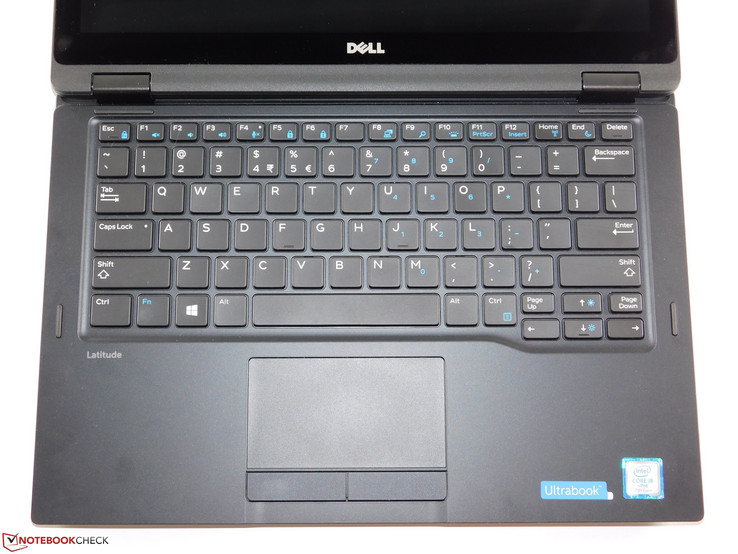
Dell offers only i display choice for this Breadth, which saves potential buyers from having to cull one. All Latitude 5289s take a 12.v-inch IPS brandish with LED backlighting and a resolution of 1920x1080 pixels, which corresponds to the Full HD standard. Convertible displays tend to be glossy and both our examination unit and HP and Lenovo's business competitors are no exception. In that location is one deviation though: the screen size. Both of the other manufacturers have gone for thirteen.iii-inch screens. The Lenovo ThinkPad Yoga 370 too has a Full Hard disk display just, the HP EliteBook x360, still, also has a UHD selection, but we tested its Full Hard disk drive display.
In its specifications, Dell says the Breadth has a screen effulgence of only 255 cd/grand². Our test unit exceeds that value significantly. On boilerplate, it reaches 320 cd/one thousand², which is a practiced value. It is a piddling lower than that of the Lenovo ThinkPad Yoga 370, only significantly higher than the HP EliteBook x360's screen brightness. The brightness distribution of xc% is quite good. Unfortunately, the display has both PWM and backlight bleeding, although at least the former is high enough not to exist a trouble for most users. The backlight haemorrhage, however, is quite strong and can be disturbing especially with dark contents.
| 306 cd/thousand² | 325 cd/m² | 323 cd/m² | ||
| 326 cd/thou² | 336 cd/yard² | 322 cd/m² | ||
| 324 cd/m² | 319 cd/chiliad² | 302 cd/k² | ||
Distribution of brightness
BOE NV12N51
X-Rite i1Pro 2
Maximum: 336 cd/m² (Nits) Average: 320.iii cd/m²
Brightness Distribution: 90 %
Middle on Bombardment: 336 cd/k²
Contrast: 988:ane (Black: 0.34 cd/one thousand²)
ΔE Colour 3.45 | 0.59-29.43 Ø5.4
ΔE Greyscale ane.68 | 0.64-98 Ø5.6
64% sRGB (Argyll 1.6.3 3D)
41% AdobeRGB 1998 (Argyll 1.6.three 3D)
44.21% AdobeRGB 1998 (Argyll 2.2.0 3D)
64.3% sRGB (Argyll ii.2.0 3D)
42.79% Brandish P3 (Argyll ii.two.0 3D)
Gamma: 2.49
| Dell Latitude 5289 BOE NV12N51, , 1920x1080, 12.50 | Lenovo ThinkPad Yoga 370-20JJS00100 Sharp LQ133M1JX15, , 1920x1080, 13.thirty | HP EliteBook x360 1030 G2 CMN1374, , 1920x1080, 13.30 | Dell XPS xiii-9365 2-in-ane 1920x1080, 13.30 | HP Spectre x360 13-w023dx Chi Mei CMN1367, , 1920x1080, 13.30 | Lenovo Yoga 910-13IKB-80VF004CGE AU Optronics AUO323D / B139HAN03.2, , 3840x2160, 13.xc | |
|---|---|---|---|---|---|---|
| Brandish | 56% | 46% | 11% | 48% | 43% | |
| Display P3 Coverage | 42.79 | 67.ix 59% | 65.5 53% | 47.32 11% | 65.4 53% | 62.two 45% |
| sRGB Coverage | 64.3 | 97.3 51% | 88.eight 38% | 71.one 11% | xc.4 41% | 90.i 40% |
| AdobeRGB 1998 Coverage | 44.21 | 69.nine 58% | 64.nine 47% | 48.83 10% | 65.8 49% | 63.5 44% |
| Response Times | -22% | -10% | 25% | 16% | vii% | |
| Response Time Greyness 50% / Grey 80% * | 42 ? | 42 ? -0% | 55.ii ? -31% | 48 ? -14% | 33.2 ? 21% | 46 ? -ten% |
| Response Time Blackness / White * | 31 ? | 32.8 ? -6% | 27.ii ? 12% | 32.8 ? -six% | 28 ? 10% | 24 ? 23% |
| PWM Frequency | 531 ? | 217.four ? -59% | 1042 ? 96% | |||
| Screen | -20% | -28% | -41% | -40% | -45% | |
| Brightness middle | 336 | 374 11% | 262 -22% | 322.six -iv% | 334.6 0% | 348 four% |
| Effulgence | 320 | 356 xi% | 256 -twenty% | 306 -four% | 319 0% | 310 -3% |
| Brightness Distribution | xc | 87 -iii% | 83 -eight% | 91 ane% | 90 0% | 80 -eleven% |
| Black Level * | 0.34 | 0.33 iii% | 0.25 26% | 0.19 44% | 0.336 ane% | 0.25 26% |
| Contrast | 988 | 1133 15% | 1048 6% | 1698 72% | 996 1% | 1392 41% |
| Colorchecker dE 2000 * | 3.45 | 4.7 -36% | five.13 -49% | vii.7 -123% | half dozen.21 -eighty% | 7.86 -128% |
| Colorchecker dE 2000 max. * | vii.95 | ix.v -19% | 9.46 -19% | xi.1 -forty% | 12 -51% | 13.43 -69% |
| Greyscale dE 2000 * | 1.68 | vi.5 -287% | 6.23 -271% | 7.9 -370% | 7.71 -359% | 8.25 -391% |
| Gamma | 2.49 88% | 2.nineteen 100% | ii.45 90% | ii.88 76% | 2.36 93% | 2.05 107% |
| CCT | 6782 96% | 7086 92% | 6413 101% | 7044 92% | 6458 101% | 6834 95% |
| Color Infinite (Per centum of AdobeRGB 1998) | 41 | 63.i 54% | 57.84 41% | 44.ane 8% | 58.6 43% | 58 41% |
| Color Space (Percent of sRGB) | 64 | 97.2 52% | 88.57 38% | 69.ix 9% | 90 41% | 90 41% |
| Total Average (Plan / Settings) | 5% / -6% | 3% / -11% | -ii% / -19% | 8% / -15% | 2% / -xx% |
* ... smaller is better
The dissimilarity (988:1) and blackness value (0.34) are good values for an IPS brandish. Subjectively, black appears inky blackness (apart from the bothersome backlight bleeding) and the image is sharp. Later calibration, the image looks even ameliorate, and then we propose using our provided ICC profile, every bit long as the Latitude 5289 that needs calibrating has a panel from BOE.
12.5-inch displays often have 1 weak indicate: colour space coverage. The Latitude 5289 is no exception; it reaches only 64% sRGB and 41% AdobeRGB, which are bad results. The xiii-inch competitors have significantly higher values. During day-to-twenty-four hours utilize, this depression color space coverage should non affect the boilerplate Part user, just does show that the used IPS display is a cheap one. You lot tin can forget image processing with this screen.
Despite the shiny surface, the Latitude can exist used outside, thanks to its bright screen. All the same, the 320 cd/g² are still not quite enough for using the device in direct sunlight, as you can see from our pictures. The epitome was visible, but not comfortable to read. You had amend notice a shady spot, as using the device in the shade is very pleasant.
Display Response Times
ℹ
Display response times show how fast the screen is able to change from one colour to the next. Slow response times can lead to afterimages and can cause moving objects to appear blurry (ghosting). Gamers of fast-paced 3D titles should pay special attending to fast response times.
| ↔ Response Time Black to White | ||
|---|---|---|
| 31 ms ... ascension ↗ and autumn ↘ combined | ↗ 18 ms rise | 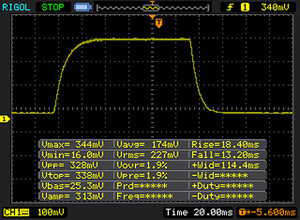 |
| ↘ xiii ms fall | ||
| The screen shows slow response rates in our tests and volition be unsatisfactory for gamers. In comparing, all tested devices range from 0.8 (minimum) to 240 (maximum) ms. » 78 % of all devices are amend. This means that the measured response time is worse than the boilerplate of all tested devices (23.five ms). | ||
| ↔ Response Time 50% Gray to lxxx% Grey | ||
| 42 ms ... ascent ↗ and autumn ↘ combined | ↗ 22 ms rise | 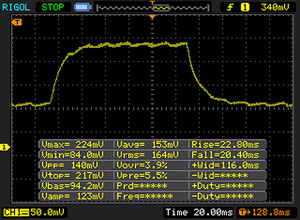 |
| ↘ twenty ms autumn | ||
| The screen shows slow response rates in our tests and will be unsatisfactory for gamers. In comparison, all tested devices range from 0.692 (minimum) to 636 (maximum) ms. » 57 % of all devices are better. This ways that the measured response time is worse than the average of all tested devices (37.1 ms). | ||
Screen Flickering / PWM (Pulse-Width Modulation)
ℹ
To dim the screen, some notebooks will but cycle the backlight on and off in rapid succession - a method called Pulse Width Modulation (PWM) . This cycling frequency should ideally be undetectable to the human heart. If said frequency is too low, users with sensitive eyes may experience strain or headaches or fifty-fifty detect the flickering altogether.
| Screen flickering / PWM detected | 531 Hz | ≤ 90 % effulgence setting | 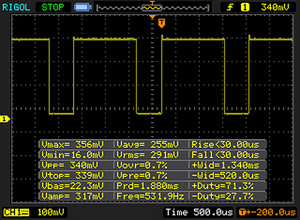 |
| The display backlight flickers at 531 Hz (Probable utilizing PWM) Flickering detected at a brightness setting of 90 % and below. There should be no flickering or PWM above this brightness setting. The frequency of 531 Hz is quite high, and so nigh users sensitive to PWM should not discover any flickering. In comparing: 52 % of all tested devices do non employ PWM to dim the brandish. If PWM was detected, an average of 22039 (minimum: 5 - maximum: 3846000) Hz was measured. | |||
As is usual for IPS displays, the device has practiced viewing-angles, although the Latitude's console is not the best representative for IPS displays. At to the lowest degree in that location are no inverted colors (different with TN panels), only you practise lose some brightness and experience a change in color temperature from wider angels. But this does not really affect twenty-four hours-to-twenty-four hours piece of work negatively.
Neither the two USB Type-C ports with DisplayPort, nor the HDMI port showed whatever problems with image output, so connecting the device to projectors or external monitors should work well.
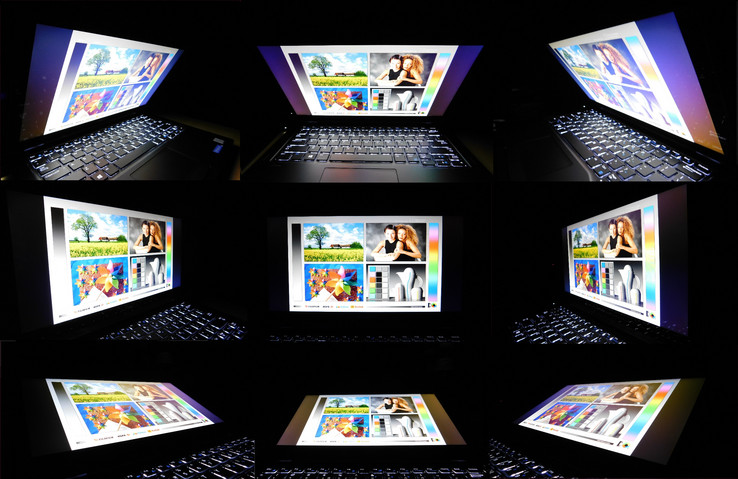
Dell's Latitude 5289 covers a price range of $1284 to $2,670 with iv different processor configurations. At entry level you will, however, simply get an i3 processor (Cadre i3-7100U), a 128 GB SSD and 4 GB of RAM (LPDDR3-1866). The latter has the most severe implications equally the RAM is firmly soldered on. Nosotros recommend thinking properly about which RAM configuration you need earlier purchase - 4 GB is quite tight in 2017. The maximum RAM available is 16 GB, only merely the virtually expensive version ($2130) is equipped with that configuration, as well equally the i7-7600U. The two lower-priced US versions tin can be equipped with SSDs of upward to 512 GB, while the two more than expensive models tin be configured with up to 1 TB PCIe SSDs. Our test unit is equipped with a 256 GB SATA III SSD. The SSDs should be easily exchangeable later on.
The users accept no options concerning graphics - the device comes with the normal iGPU simply. But that is not surprising for a pocket-sized convertible. On top of RAM, CPU and SSD, users should as well accept a wait at the battery. Some models just have a 45 Wh battery, while our test unit has a larger 60 Wh battery.
The Core i5-7300U is the faster of the two Intel Cadre i5 CPUs of the U series (with a TDP of 15 Wh). It is used a lot less than its slower sister version, the i5-7200U, which is probably because the speed advantage is not that big and that the more expensive i5-7300U has vPro - a office that individual users are not likely to need. The two cores of the i5-7300U clock at a maximum of three.v GHz with an boilerplate clock rate of 2.6 GHz. Please cheque our CPU database for more data.
In lodge to examination a notebook's operation in day-to-twenty-four hours use, we make all laptops practise a brusque endurance examination: the Cinebench Multicore benchmark runs in a loop for 30 minutes. If the performance drops, we know that the full CPU operation will non be bachelor for long during day-to-day use. We noticed this on the Latitude 5289 equally well. The power dropped to most 325 points after the first round, which is merely below the Core i7-7200U operation. Afterward that, the CPU stays at that level. The reason behind this driblet is the TDP (Thermal Design Ability) of 15 Wh. During the first round, the CPU is immune to eat 21 Wh for about thirty seconds, during which it can apply the maximum clock rate of iii.5 GHz. Afterwards that, the TDP limit of 15 Wh sets in and the clock charge per unit drops to 3 GHz. There is no throttling, just maximum performance is not reached either.
Cinebench R15 CPU Multi 64 Fleck
The Latitude 5289 with the i5-7300U delivers quite adept results in the individual tests - above the usual results for the i5-7200U, which typically reaches 330 points. Our test unit of measurement cannot make the about of its processor, which y'all can come across from looking at the slightly meliorate results of the EliteBook x360 with the same CPU. Only it nevertheless beats the Lenovo ThinkPad Yoga 370 with the i5-7200U processor. (That device is fifty-fifty farther away from reaching its full potential.) You can compare more CPUs with our CPU benchmark tool.
Our test unit CPU performs only as well on bombardment ability as when continued to a power supply.
Cinebench R15 OpenGL 64Bit
46.69 fps
Cinebench R15 Ref. Match 64Bit
97.7 %
Cinebench R15 CPU Multi 64Bit
340 Points
Cinebench R15 CPU Unmarried 64Bit
145 Points
Help
Cypher bad tin be said regarding organisation performance. Both during normal utilize and during the tests our examination unit performed relatively well and ranks average in the benchmarks. Subjectively, everything runs smoothly.
| PCMark 8 | |
| Home Score Accelerated v2 | |
| HP Spectre x360 13-w023dx | |
| HP EliteBook x360 1030 G2 | |
| Lenovo Yoga 910-13IKB-80VF004CGE | |
| Dell Latitude 5289 | |
| Lenovo ThinkPad Yoga 370-20JJS00100 | |
| Dell XPS 13-9365 two-in-1 | |
| Work Score Accelerated v2 | |
| HP Spectre x360 13-w023dx | |
| HP EliteBook x360 1030 G2 | |
| Dell Latitude 5289 | |
| Dell XPS thirteen-9365 2-in-1 | |
| Lenovo ThinkPad Yoga 370-20JJS00100 | |
| PCMark 8 Dwelling Score Accelerated v2 | 3554 points | |
| PCMark 8 Work Score Accelerated v2 | 4681 points | |
| Help | ||
Equally mentioned above, our test unit contains an SSD with a capacity of 256 GB. It was produced by SanDisk and the model is X400. It is a normal SATA III SSD, but Dell's Latitude 5289 is also available with the more expensive PCIe SSDs in the US. This means the Breadth is at a disadvantage in the benchmark comparison. The EliteBook x360 is the but other device with the cheaper SATA Iii configuration. The test unit would probably take done improve in the PCMark-Test if it had a PCIe SSD. Information technology would exist possible to mount a PCIe SSD afterward on, if needed.
You can compare the SanDisk X400 with other SSDs in our HDD/SSD Benchmark table.
| Dell Latitude 5289 SanDisk X400 256GB, SATA (SD8SB8U-256G) | Lenovo ThinkPad Yoga 370-20JJS00100 Toshiba NVMe THNSF5512GPUK | HP EliteBook x360 1030 G2 Sandisk SD8TN8U-256G-1006 | Dell XPS thirteen-9365 2-in-1 Toshiba NVMe THNSN5256GPUK | HP Spectre x360 13-w023dx Samsung PM951 NVMe MZVLV512 | Lenovo Yoga 910-13IKB-80VF004CGE Samsung PM951 NVMe MZVLV512 | |
|---|---|---|---|---|---|---|
| CrystalDiskMark iii.0 | 128% | 33% | 130% | 154% | 179% | |
| Read Seq | 423.seven | 1070 153% | 467.i 10% | 1206 185% | 1376 225% | 1412 233% |
| Write Seq | 406.4 | 484.5 19% | 443.6 9% | 629 55% | 571 41% | 578 42% |
| Read 512 | 260.8 | 680 161% | 312.3 twenty% | 966 270% | 679 160% | 701 169% |
| Write 512 | 255.six | 483.1 89% | 372.5 46% | 410.seven 61% | 571 123% | 580 127% |
| Read 4k | 22.73 | thirty.55 34% | 29.43 29% | 32.93 45% | 42.66 88% | 43.5 91% |
| Write 4k | 27.92 | 127.3 356% | 56.5 102% | 121.2 334% | 137.nine 394% | 159.vii 472% |
| Read 4k QD32 | 306.ii | 460.8 50% | 311.iii ii% | 411 34% | 535 75% | 570 86% |
| Write 4k QD32 | 158.eight | 414.five 161% | 225.ii 42% | 250.2 58% | 361.two 127% | 488.7 208% |
Sequential Read: 423.7 MB/s
Sequential Write: 406.4 MB/s
4K QD32 Write: 158.8 MB/s
Sequential Read: 449.7MB/south
Sequential Write: 202.7MB/s
Access Fourth dimension Read: 0.225ms
Admission Time Write: 0.127ms
The Intel HD Graphics 620 is one of the virtually tested graphics unit of the electric current notebook generation. After all, the GT2 based (24 Execution Units) iGPU is featured in every device with a U series processor - which is basically the standard for notebooks present.
The device's storage solution is crucial to the operation of the Hard disk 620, equally information technology has no retentiveness of its own. If simply ane memory module is available, as is the case in the ThinkPad Yoga 370, the maximum performance is limited. This is called single channel mode. If at that place is a second retentivity module available, the GPU can perform better thanks to dual-aqueduct fashion. In the case of the Latitude 5289, the memory is soldered on and runs in dual-channel mode. That should exist the primary reason why the test unit does quite a good chore in the benchmarks. It is 18 to 22 percent faster than the ThinkPad Yoga 370's single channel mode. As always, yous tin also compare GPUs in our GPU Benchmark Tool.
The GPU performs just as well in battery mode and on power supply.
| 3DMark eleven - 1280x720 Performance GPU | |
| Dell Latitude 5289 | |
| Lenovo Yoga 910-13IKB-80VF004CGE | |
| HP Spectre x360 13-w023dx | |
| HP EliteBook x360 1030 G2 | |
| Dell XPS 13-9365 2-in-1 | |
| Lenovo ThinkPad Yoga 370-20JJS00100 | |
| 3DMark | |
| 1280x720 Cloud Gate Standard Graphics | |
| Lenovo Yoga 910-13IKB-80VF004CGE | |
| Dell Latitude 5289 | |
| HP EliteBook x360 1030 G2 | |
| HP Spectre x360 13-w023dx | |
| Dell XPS 13-9365 2-in-ane | |
| Lenovo ThinkPad Yoga 370-20JJS00100 | |
| 1920x1080 Burn down Strike Graphics | |
| Dell Breadth 5289 | |
| Lenovo Yoga 910-13IKB-80VF004CGE | |
| HP EliteBook x360 1030 G2 | |
| HP Spectre x360 thirteen-w023dx | |
| Dell XPS 13-9365 2-in-1 | |
| Lenovo ThinkPad Yoga 370-20JJS00100 | |
| 3DMark 11 Functioning | 1787 points | |
| 3DMark Cloud Gate Standard Score | 6359 points | |
| 3DMark Burn Strike Score | 931 points | |
| Assistance | ||
When you hear the proper noun "Latitude", gaming is probably the last thing y'all will retrieve of. Still, gaming probably plays a role for some people, equally diligent keyboard-warriors might like to treat themselves to a quick game after work.
But of course the Latitude 5289 is not made for that - which becomes articulate in the game benchmarks. Current games are a complete no-go and even older games are not playable with high details and 1080p.
If you want to play games in adept quality, you had better look for a multimedia or gaming laptop.
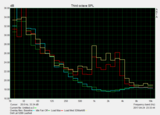
The test unit of measurement's fan is nice and quiet. While idling, the cooling fan is turned off, and even under load, it does not run too high. It is conspicuously audible, simply not agonizing.
What is more than disturbing is the penetrating coil whine that is regularly audible during use. This is a articulate minus point for sensitive users and will negatively impact our total rating.
Noise Level
| Idle | 30.v / 30.5 / 30.5 dB(A) | |
| Load | 36 / 34.6 dB(A) | |
 | ||
| 30 dB twoscore dB(A) l dB(A) | ||
| min: | ||
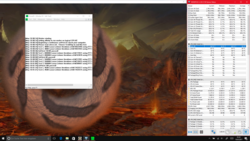
As is typical for an Ultrabook, the Latitude 5289 remains completely absurd while idling. It does oestrus up noticeably nether load in some areas, although a temperature of 49 °C (~120 °F) is still acceptable. Luckily, the wrist rest remains cool. The lesser of the base of operations heats up in some areas, non enough to have to worry nigh burning yourself.
Taking a look at the internal temperature values during the stress test, you can come across that the stress test reflects the results of the Cinebench loop test quite well. The organisation can go over the TDP limit for nearly 30 seconds - although in this example the CPU clocks at but three GHz equally the iGPU is running at full capacity equally well. After that, the CPU clock rate sinks to 1.eight GHz at which it stays for the remainder of the test. These results show that the TPD does cause throttling, which is typical for Ultrabook processors. The manufacturer could probably avoid this by increasing the TDP to 25 Wh, but then the temperatures would probably increase a lot, as these are held in check by the throttling.
The 3DMark11 test that nosotros did later the stress exam brought average results.
| |||||||||||||||||||||||||
| Maximum: 49 °C = 120 F Average: 36.7 °C = 98 F | |||||||||||||||||||||||||
| |||||||||||||||||||||||||
| Maximum: 44.4 °C = 112 F Average: 34.7 °C = 94 F | |||||||||||||||||||||||||
Power Supply (max.) 35.8 °C = 96 F | Room Temperature 20.7 °C = 69 F | FIRT 550-Pocket
| |||||||||||||||||||||||||
| Maximum: 28.half dozen °C = 83 F Boilerplate: 26.iv °C = 80 F | |||||||||||||||||||||||||
| |||||||||||||||||||||||||
| Maximum: 28.three °C = 83 F Boilerplate: 26.vii °C = lxxx F | |||||||||||||||||||||||||
Power Supply (max.) 28.2 °C = 83 F | Room Temperature 21.5 °C = 71 F | FIRT 550-Pocket
(±) The boilerplate temperature for the upper side under maximal load is 36.7 °C / 98 F, compared to the average of 30.2 °C / 86 F for the devices in the grade Convertible.
(-) The maximum temperature on the upper side is 49 °C / 120 F, compared to the average of 35.3 °C / 96 F, ranging from 21 to 55.7 °C for the course Convertible.
(±) The bottom heats up to a maximum of 44.4 °C / 112 F, compared to the average of 36.vi °C / 98 F
(+) In idle usage, the boilerplate temperature for the upper side is 26.iv °C / 80 F, compared to the device average of thirty.2 °C / 86 F.
(+) The palmrests and touchpad are cooler than skin temperature with a maximum of thirty.two °C / 86.4 F and are therefore cool to the bear upon.
(±) The average temperature of the palmrest area of like devices was 28.four °C / 83.1 F (-1.8 °C / -three.three F).
The stereo speakers are placed at the lesser, almost the front of the base unit. The audio is directed out of the instance via the bottom of the base. Therefore, the quality of the sound depends on what the device is standing on; if it is standing on something soft, the sound will be muted. The Latitude'southward sound itself is nada special and rather typical for notebook speakers: depression frequencies are hardly audible and the sound is not particularly loud.
The sound quality improves significantly when yous connect external speakers or headphones via the flawless 3.5mm combined audio jack.
Dell Latitude 5289 audio analysis
(-) | not very loud speakers (69 dB)
Bass 100 - 315 Hz
(-) | nearly no bass - on average 19.6% lower than median
(±) | linearity of bass is boilerplate (11.1% delta to prev. frequency)
Mids 400 - 2000 Hz
(+) | balanced mids - merely three.2% away from median
(±) | linearity of mids is average (7.vii% delta to prev. frequency)
Highs 2 - 16 kHz
(±) | college highs - on average 5.2% higher than median
(±) | linearity of highs is average (9.5% delta to prev. frequency)
Overall 100 - 16.000 Hz
(±) | linearity of overall audio is boilerplate (20.7% difference to median)
Compared to same grade
» 56% of all tested devices in this grade were better, 8% similar, 36% worse
» The best had a delta of half dozen%, average was xx%, worst was 53%
Compared to all devices tested
» 53% of all tested devices were improve, nine% like, 38% worse
» The best had a delta of iii%, average was 20%, worst was 65%
Apple MacBook 12 (Early 2016) i.1 GHz audio analysis
(+) | speakers tin can play relatively loud (83.6 dB)
Bass 100 - 315 Hz
(±) | reduced bass - on average 11.three% lower than median
(±) | linearity of bass is average (14.2% delta to prev. frequency)
Mids 400 - 2000 Hz
(+) | balanced mids - only 2.iv% away from median
(+) | mids are linear (5.5% delta to prev. frequency)
Highs 2 - 16 kHz
(+) | balanced highs - merely 2% away from median
(+) | highs are linear (four.5% delta to prev. frequency)
Overall 100 - sixteen.000 Hz
(+) | overall sound is linear (9.iii% departure to median)
Compared to same class
» 2% of all tested devices in this class were better, i% similar, 97% worse
» The best had a delta of vii%, average was 19%, worst was fifty%
Compared to all devices tested
» two% of all tested devices were improve, ane% similar, 97% worse
» The best had a delta of 3%, average was twenty%, worst was 65%
Frequency diagram in comparison (checkboxes above can be turned on/off)
The Latitude 5289 has great values, especially while idling. Out of all comparison devices with 15 Westward U processors, it is clearly the near energy-efficient device. Merely the Dell XPS 13 2-in-1 is amend - just that is equipped with a considerably more energy-efficient Y processor. At to the lowest degree the minimal idle value is lower in the Latitude 5289 despite the stronger CPU. Dell did a good task here.
The exam unit comes with a 65 Wh ability supply with a USB-C connector. The 65 Wh are more than enough, theoretically Dell could take also used a 45 Wh power supply.
| Dell Breadth 5289 i5-7300U, Hard disk Graphics 620, SanDisk X400 256GB, SATA (SD8SB8U-256G), IPS LED, 1920x1080, 12.50 | Lenovo ThinkPad Yoga 370-20JJS00100 i5-7200U, HD Graphics 620, Toshiba NVMe THNSF5512GPUK, IPS LED, 1920x1080, 13.thirty | HP EliteBook x360 1030 G2 i5-7300U, HD Graphics 620, Sandisk SD8TN8U-256G-1006, IPS, 1920x1080, 13.30 | Dell XPS thirteen-9365 two-in-i i7-7Y75, HD Graphics 615, Toshiba NVMe THNSN5256GPUK, IPS, 1920x1080, 13.thirty | HP Spectre x360 13-w023dx i7-7500U, HD Graphics 620, Samsung PM951 NVMe MZVLV512, IPS, 1920x1080, xiii.xxx | Lenovo Yoga 910-13IKB-80VF004CGE i7-7500U, Hd Graphics 620, Samsung PM951 NVMe MZVLV512, IPS, 3840x2160, 13.90 | |
|---|---|---|---|---|---|---|
| Ability Consumption | -17% | -nine% | 17% | -xxx% | -20% | |
| Idle Minimum * | 2.7 | three.6 -33% | 3.2 -19% | three.one -15% | v.5 -104% | iv.iii -59% |
| Idle Boilerplate * | 5.1 | 7.ii -41% | v.5 -8% | iv.three 16% | six.vii -31% | half-dozen.3 -24% |
| Idle Maximum * | vii.6 | 8.4 -11% | 6.5 14% | 4.9 36% | seven.ane 7% | 9 -xviii% |
| Load Average * | 33 | 29.9 9% | 29.7 x% | 24.iii 26% | 33.ane -0% | 32.vii ane% |
| Load Maximum * | 29 | 32.2 -11% | 41.3 -42% | 22.8 21% | 35.2 -21% | 28.8 i% |
* ... smaller is improve
The low consumption rates and comparatively enormous 60 Wh battery that our test unit is equipped with ensure excellent bombardment runtimes. During our practically oriented Wi-Fi test, the Latitude even beats the EliteBook x360 , which already has very good runtimes. Our test unit was on for 28 hours during our idle test - the longest fourth dimension by far. It but lagged behind a little while testing its battery runtime under load.
It takes about 1.5 hours for the bombardment to recharge fully, which is quite fast for a 60 Wh battery.
Bombardment Runtime
| Idle (without WLAN, min brightness) | 28h 48min | |
| WiFi Websurfing (Edge) | 11h 48min | |
| Load (maximum effulgence) | 2h 16min |
| Dell Latitude 5289 i5-7300U, HD Graphics 620, 60 Wh | Lenovo ThinkPad Yoga 370-20JJS00100 i5-7200U, HD Graphics 620, 51 Wh | HP EliteBook x360 1030 G2 i5-7300U, Hard disk Graphics 620, 57 Wh | Dell XPS 13-9365 two-in-1 i7-7Y75, Hd Graphics 615, 46 Wh | HP Spectre x360 13-w023dx i7-7500U, HD Graphics 620, 57.8 Wh | Lenovo Yoga 910-13IKB-80VF004CGE i7-7500U, Hard disk drive Graphics 620, 78 Wh | |
|---|---|---|---|---|---|---|
| Battery Runtime | -24% | 16% | -6% | -twenty% | -6% | |
| Reader / Idle | 1728 | 1163 -33% | 1387 -20% | 971 -44% | 1233 -29% | 1069 -38% |
| WiFi v1.3 | 708 | 488 -31% | 630 -xi% | 686 -3% | 558 -21% | 644 -9% |
| Load | 136 | 127 -7% | 244 79% | 175 29% | 121 -eleven% | 174 28% |
| H.264 | 576 | 659 |
Pros
+ robust case
+ like shooting fish in a barrel typing on the keyboard
+ cooling fan is often turned off
+ a adept selection of ports for day-to-twenty-four hours use
+ bright display
+ swell battery runtime
Cons
- disappointing touchpad
- brandish: low colour space coverage and too much backlight bleeding
- disturbing coil whine
- no Thunderbolt 3
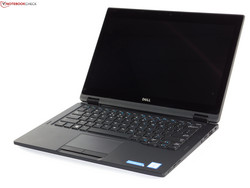
Choosing a business concern convertible is non easy. After all the ThinkPad Yoga 370 and the EliteBook x360 alone are two skillful alternatives. With the Latitude 5289, Dell has contributed an interesting competitor. The biggest advantage of today'southward test unit: its battery runtime. Thanks to depression energy consumption and a very big battery, the Latitude is the best device in this area. The robust example and comfy keyboard are besides worth considering. The Latitude 5289's cooling fan remains tranquility thanks to its ULV CPU. The selection of ports is suitable for a business device, which brings u.s. to the negative aspects.
A device that is clearly to a higher place the $1,000 marker should be equipped with Thunderbolt three and its competitors all feature the port. The cooling fan does not run very oft, just Dell has not managed to get rid of the bothersome roll whine. The keyboard is expert; the touchpad, withal, is non impressive; peculiarly in comparing to the competitors from HP and Lenovo, the touchpad Dell chose is not not bad. Unlike Lenovo and HP, Dell has called to continue the 12.5-inch display. This tin can be an advantage or a disadvantage: yous have less piece of work surface, but too less weight. A typical disadvantage of 12.5-inch displays is the defective color space coverage. On top of that, the display has high backlight bleeding. At least it is bright enough to use outdoors.
Dell has created a good convertible: its long battery runtime is especially captivating. But it is not easy to keep up in this highly competitive market, and Dell did make some mistakes.
The Breadth 5289 is definitely non a bad convertible. If you are looking for a convertible notebook with the longest possible battery runtime, so this could even be a recommendable choice. However, the alternatives - ThinkPad Yoga 370 and EliteBook x360 - equally have their potent points. The entry-level model of the Latitude costs less, but yous also get a worse configuration with only iv GB of soldered-on working retentivity. Overall, the Breadth has a hard time asserting itself against its competitors. Information technology could beat them with a better xiii.3-inch display and an improved touchpad. Instead, it remains in third identify despite its great battery runtime, particularly because both Lenovo'southward and HP's models offering good battery runtimes also.
Dell Latitude 5289 - 2017-05-16 05/16/2017 v6(sometime)
Benjamin Herzig
Convertible - Weighted Average
Pricecompare
Benjamin Herzig, 2017-05-19 (Update: 2019-04- five)
makinsonfoughurpite.blogspot.com
Source: https://www.notebookcheck.net/Dell-Latitude-5289-i5-256GB-8GB-Convertible-Review.221832.0.html

0 Response to "Dell Latitude 5289 125 Fhd/touchscreen Business Convertible Review"
Post a Comment